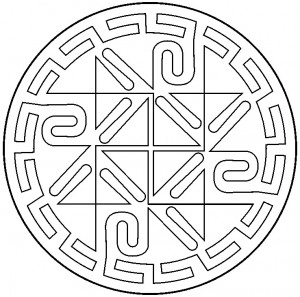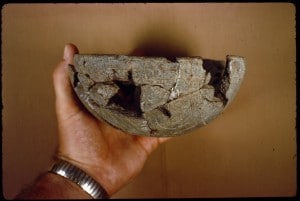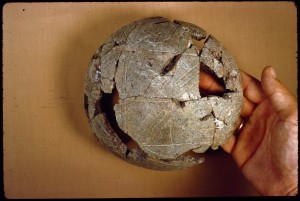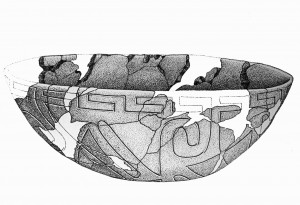Little known fact: The Arkansas Archeological Survey logo is taken from an engraved stone bowl recovered from Columbia County–about eight miles south of Magnolia.
In 1970, a local collector found a few fragments of an engraved bowl on a small site called King’s Creek (3CO26) south of town. Dr. Schambach returned to the site with the collector and some volunteers (MacRae Blackwell, Bev and Sam Watkins, and Cynthia Weber) and sifted the plow zone in the immediate vicinity of the initial surface finds. They subsequently discovered about 2/3 of the bowl in pieces. The bowl (reassembled by the collector) is 8 to 10 cm high and has oral diameters of 24 cm on its long axis and 18 cm on the short axis; the wall thickness varies from 3 mm to 13 mm at the thickest. It is carved about of steatite–a soft stone used to make bowls in the Poverty Point period (2000 B.C. to 600 B.C). We do find stone bowls in this period, but decorated ones are rare, which makes it some of the earliest artwork in the eastern US.
Louis Gregoire, then an artist with the Arkansas Archeological Survey, made careful measurements and rendered the design long used as the Survey’s logo.
The outstanding stylistic trait of the design is that it is composed of a single continuous line. The entire design can be traced without hitting a break in the line, backtracking or going over the same segment twice. This single line technique seems to be a basic one in the later woodland cultures. For instance, Marksville art as it is expressed in the recursive bird designs on Marksville pottery and, further afield, it occurs on Hopewellian pottery and on the famous Adena tablets.
Edits:
2025-07-16: Drexler removed the collector’s name due to the collector’s wishes for anonymity and also corrected the site number and year of find.




